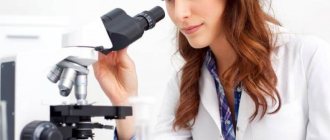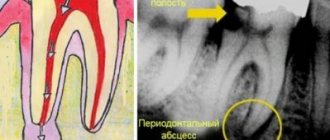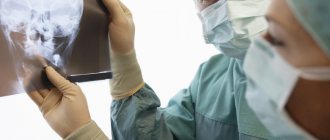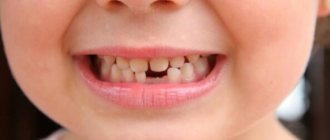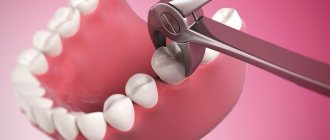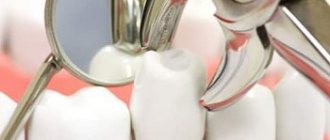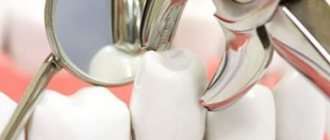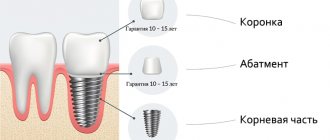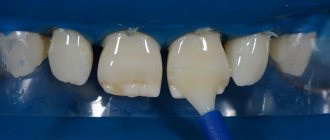Radiovisiographic examination is a method of computer radiographic examination in dentistry. Its goal is to obtain an image of the tooth and tissues around it with minimal radiation exposure. It has proven itself well in diagnosing hidden carious processes, inflammation of the pulp or periodontium, and identifying foreign objects in the tooth canal. Thanks to him, the dentist has the opportunity to control the quality and effectiveness of the treatment. During the procedure, a detector is inserted into the oral cavity, which is aimed at the area under study: its image is displayed on the monitor.
You can undergo radiovisiography in Moscow at the dental department of CELT. Our clinic has been operating in the capital's paid medical services market for almost three decades. We have a modern radiovisiograph, which allows us to accurately and quickly make diagnoses, identifying diseases in the early stages of their development. Our surgeons, orthodontists, therapists, and orthopedists have decades of experience in scientific and practical work. They constantly improve their professional knowledge and skills and use effective and gentle treatment methods. You can find out the price of the study by going to the “Services and Prices” tab. To avoid misunderstandings, check the numbers with the information line operators or at your doctor’s appointment.
Consultation with a dentist-therapist - 1,000 rubles.
Radiovisiographic examination - 370 rubles.
At CELT you can get advice from a dental specialist.
- The cost of a consultation with a dentist-therapist is 1,000
Make an appointment
Radiovisiography in dentistry
Without radiovisiographic examination, diagnostics in dentistry would be impossible. This is computer radiography, which replaced the outdated film radiography. Thanks to it, you can get a clear image in just a few seconds, while the patient’s radiation exposure will be minimal - ten times less than when using a film device.
A digital visiograph is equipment that should be in any modern dental clinic, since today it is the only method that fully complies with international standards. Its operation is based on the same principle as a standard device, but the signal is sent not to the film, but to the CCD sensor (or, as it is also called, the matrix). The latter has greater light sensitivity than conventional film, so minimal exposure to radiation is sufficient to obtain a clear image.
The visiograph sensor is connected to a converter, which reads its signals, transforming them into a digital image. The latter is sent to the monitor where the doctor can see it. The digital format also has many advantages: it does not take up much space on your hard drive, where it can be stored for a long time, it can be transferred to a USB drive or sent by email.
How profitable is this?
And now the main question is why buy it. This is where elementary arithmetic comes to the rescue. The average cost of one package of film (1 package – 50 pictures) is 1250 rubles. The average daily throughput of the X-ray room is 15 patients. Taking into account the defect rate of 1/5, this is 20 shots per day. It turns out that one package of film is enough for 2.5 days. 144 packages are needed per year with a total cost of 180,000 rubles. And this does not take into account chemical reagents. With the average cost of a photo for a client being 120 rubles, the revenue will be 864,000 rubles. Thus, the net profit will be 684,000 rubles per year.
Let's now look at the visiograph. Its average price on the Russian market (with a resource of 400,000 images) is 130,000 rubles. Of course, there are obvious benefits. Add to this the simplest maintenance (you will have to clean it with soapy water or isopropyl alcohol), and a rather long service life.
You can purchase a visiograph by following the link.
Indications and contraindications for dental radiovisiography
The study can be used for targeted study of dental units, as well as for identifying hidden carious processes and inflammation of surrounding structures.
Indications
- Diagnosis of caries, inflammatory processes of pulp and periodontium;
- Monitoring their treatment (quality of endodontic treatment, in particular, filling of canals, correct placement of pins, tightness of seal to the walls of the tooth);
- Preparation for surgery to increase bone tissue to determine the degree of its atrophy and the characteristics of the process;
- Suspicions of neoplasms in the thickness of the soft tissues of the oral cavity;
- Cystic formations and granulomas at the roots of teeth;
- Determining the location of fragments of broken dental instruments in the root canal;
- Traumatic damage to a tooth (dislocation, bruise, fracture);
- Control of the implant after installation;
- Before sealing the fissures of teeth in order to ensure the absence of caries.
Contraindications
Absolute contraindications:
- The patient has serious mental disorders;
- Pathologies of a neurological nature;
- Depressive states.
Due to the minimal level of radiation, radiovisiography of the maxillofacial area can be performed on a child, provided that he can sit still for several seconds.
If indicated, the study can be performed on women during pregnancy and lactation. It is optimal to do this in the second trimester, after warning the diagnostician about pregnancy. This is necessary so that she is put on a special apron, which provides additional protection from x-rays.
Rules of service
To maintain hygiene conditions, the sensor must be placed in a special polyethylene case before being placed in the patient’s mouth.
For normal operation, the visiograph also requires cleaning using a soap solution or isopropyl alcohol. Before cleaning, you must turn off the power to the device. Since some disinfecting liquids can form explosive compounds when evaporated, in order to avoid ignition when turning on the visiograph after cleaning, some time is required to allow the vapors of these liquids to evaporate from the room.
IMPORTANT. It is extremely dangerous for the device if moisture gets inside the sensor or control unit. If liquid gets on the device board, it can cause a short circuit.
Advantages of radiovisiographic examination
This research method is considered the best option both for a dental office and for a large clinic in which several specialists work at once. Its advantages:
- Efficiency and the ability to receive an image instantly, without waiting;
- High clarity and information content of the image, in which you can see the condition of the teeth, surrounding tissues, and implants;
- Minimum number of restrictions (possibility of use for children and pregnant patients);
- Convenient digital format, the ability to print the image on paper.
Do not forget that visiography is an environmentally friendly and harmless research method. It does not require the use of film or aggressive chemicals for development. The radiation dose received during filming of the lower jaw is 2 microsieverts, the upper – 5 microsieverts. For comparison, when using a film apparatus, it is equal to 30 and 80 microsieverts, respectively.
The resulting images clearly show:
- Carious lesions, cystic formations, granulomas and inflammatory processes. They are transmitted in black;
- Fillings, inlays, pins, dentures – white areas;
- Connective and bone tissue are gray areas.
Flaws
Radiovisiography has only one disadvantage - the spatial resolution is one and a half to two times lower than that of film. Because of this, the sensor does not clearly convey the difference between structures that differ significantly in density. However, this shortcoming is compensated by the ability to correct the brightness and contrast of a digital image.
Shot on film
Reviews about our dental therapists
I would like to express my gratitude to the dentist Elena Nikolaevna Kiseleva and her assistant Svetlana - they are real specialists and at the same time sensitive, not burnt out by years of practice.
Thanks to them, I have been coming back here for many years. Thanks to the management for such doctors! Read full review Svetlana Nikolaevna
13.08.2021
I am very grateful to Evgeniy Borisovich Antiukhin for removing my three eights. Especially considering that the lower tooth was not the simplest (it was located in an embrace with a nerve). The removal took place in 2 stages, one tooth under local anesthesia, two under general anesthesia. I had no idea that wisdom teeth could be... Read full review
Sofia
28.12.2020
How is dental radiovisiography performed?
The procedure is very simple and absolutely painless and does not require preparation. The patient is asked to take a sitting position on a chair near the device, after which a sensor is applied to the area under study and the patient is asked to gently bite the sensor with his teeth. This prevents its displacement. After this, the tube of the device is directed to a certain area of the jaw. The diagnostician starts it, and X-rays begin to illuminate the tissue. The signals are captured by the sensor, then sent to the converter and (already in the form of a graphic image) to the monitor.
Difference between radiovisiography, OPTG and computed tomography
Unlike visiography, OPTG - orthopantogram (or, as it is also called, panoramic image) covers not one or three teeth, but the entire dental system. An orthopantomograph is used to obtain images. Most often, such diagnostics are prescribed to young patients in order to assess the condition of the rudiments of permanent teeth. As for computed tomography, it provides not a two-dimensional, but a three-dimensional image of the patients’ jaw system. For this reason, it is carried out before implantation and bone augmentation operations that precede it, in order to plan them in detail.
You can make an appointment with dentists and undergo radiovisiography at CELT online or by contacting our information line operators: +7 (495) 788‑33‑88.
Make an appointment through the application or by calling +7 +7 We work every day:
- Monday—Friday: 8.00—20.00
- Saturday: 8.00–18.00
- Sunday is a day off
The nearest metro and MCC stations to the clinic:
- Highway of Enthusiasts or Perovo
- Partisan
- Enthusiast Highway
Driving directions
Network of medical clinics "Our Doctor"
Professional oral hygiene, radiology, any dental procedures, orthodontics, dental orthopedics, dental surgery, dental prosthetics, installation of braces and veneers. We work only with high-quality dental brands and time-tested materials. Dentists at the clinic Dr. Alice Rich in Moscow will help solve any dental health problems and give you back the opportunity to smile freely.
Initial consultation
For free
Application anesthesia
100 ₽
Infiltration anesthesia
400 ₽
Conduction anesthesia
400 ₽
Radiovisiographic examination (sight image)
400 ₽
Professional oral hygiene (ultrasonic scaling, Air-flow, deep fluoridation, polishing)
5 000 ₽
Professional hardware whitening “BEYOND”
15 000 ₽
Professional oral hygiene (ultrasonic scaling, AIR-FLOW, deep fluoridation, polishing)
5 000 ₽
Hygiene training, supervised cleaning
600 ₽
Removal of dental plaque in the area of 1 tooth (ultrasonic scaling)
200 ₽
AIR-FLOW 1 jaw
2 500 ₽
Deep fluoridation, desensitization
200 ₽
Closed curettage in the area of 1 tooth
500 ₽
Open curettage in the area of 1 tooth
1 000 ₽
Medical treatment of 1 periodontal pocket
300 ₽
Using a therapeutic dressing, film (METROGYL-DENTA, solcoseryl, Diplen and others) in the area of two teeth
300 ₽
Gingivectomy in the area of 1 tooth
1 200 ₽
Gingivotomy in the area of 1 tooth
600 ₽
Opening a periodontal abscess
1 200 ₽
Closed curettage of the periodontal pocket (in the area of 1 tooth)
1 000 ₽
Open curettage of the periodontal pocket (in the area of 1 tooth)
1 500 ₽
Stitching (from 1 to 4)
600 ₽
Selective grinding of 2 teeth
500 ₽
Splinting of mobile teeth (1 unit)
1 000 ₽
Use of osteoplastic material (such as “Callapan”, “Parodontol” and others)
1 000 ₽
Contouring of the gingival margin with a diode laser in the area of one tooth
600 ₽
Laser treatment of one periodontal pocket
600 ₽
Injection with anti-inflammatory drug "Traumel"
500 ₽
Application anesthesia
100 ₽
Infiltration anesthesia
400 ₽
Conduction anesthesia
400 ₽
Radiovisiographic examination (sight image)
400 ₽
Placement of filling, 1 surface (Charisma)
2 100 ₽
Placement of filling, 1 surface (Gradia)
2 800 ₽
Placement of filling, 2 surfaces (Charisma)
3 100 ₽
Placement of filling, 2 surfaces (Gradia)
3 800 ₽
Placement of filling, 3 surfaces (Charisma)
3 600 ₽
Placement of filling, 3 surfaces (Gradia, Estelite)
4 600 ₽
Reconstruction of a wedge-shaped defect
2 600 ₽
Installing the fiberglass pin
700 ₽
Applying an insulating pad
200 ₽
Applying a therapeutic pad
300 ₽
Restoration (veneer)
4 500 ₽
Restoration of a tooth stump for a crown using heliocomposite material
2 500 ₽
Removing the anchor pin
1 000 ₽
Removing a foreign body from the canal
1 500 ₽
Selective grinding in the area of 1 tooth
200 ₽
Placing a temporary filling
400 ₽
Splinting of mobile teeth (1 unit)
1 000 ₽
Placing a rubber dam
500 ₽
Setting up a matrix system
400 ₽
Unsealing 1 channel filled with paste
700 ₽
Unsealing 1 canal filled with gutta-percha
800 ₽
Unsealing 1 canal filled with resorcinol-formalin method
1 100 ₽
Mechanical and medicinal treatment of 1 root canal
400 ₽
Filling 1 root canal with gutta-percha and sealer
1 500 ₽
The use of calcium-containing preparations for the treatment of 1 root canal (Metapex, Metapasta, Calasept)
600 ₽
Polishing the filling
300 ₽
Deep fluoridation of 1 tooth
200 ₽
Professional oral hygiene (ultrasonic scaling, Air-flow, deep fluoridation, polishing)
5 000 ₽
Desensitization Seal & Protect
500 ₽
Sealing the fissures of 1 tooth
500 ₽
Application of devitalizing paste
500 ₽
Removal of dental plaque in the area of 1 tooth (ultrasonic scaling)
200 ₽
Remineralizing dental therapy (1 jaw)
500 ₽
Whitening 1 tooth
1 500 ₽
Closing the perforation
1 500 ₽
Repair of metal-ceramic surface (1 crown)
3 000 ₽
Diathermocoagulation in the area of 1 tooth
200 ₽
Application anesthesia
100 ₽
Infiltration anesthesia
400 ₽
Conduction anesthesia
400 ₽
Radiovisiographic examination (sight image)
400 ₽
Easy removal
1 500–2 500 ₽
Difficult removal
3500 ₽
Removal of the 8th tooth
4 000–6 000 ₽
Removal of an impacted or partially impacted tooth
6 000–10 000 ₽
Excision of the hood
1 000 ₽
Incision, drainage
1 000 ₽
Coagulation
300 ₽
Applying from 1 to 4 stitches
600 ₽
Tongue frenuloplasty, lip and vestibuloplasty
5 000 ₽
Use of osteoplastic material of the “COLLAPAN” type (membrane, granules)
1 500–5 000 ₽
Use of osteoplastic material such as “BioOss” (membrane, granules)
8 000–12 000 ₽
Alveolotomy in the area of 1 tooth
1 300 ₽
Treatment of alveolitis
1 200 ₽
Dressing, changing drainage
200 ₽
Gingivectomy of 1 tooth
1 200 ₽
Cystectomy (apex resection, hemisection, replantation)
5 000–10 000 ₽
Use of the drug "Alvozhil", "Neoconus"
300 ₽
Opening of periosteal, periodontal abscess
1 500 ₽
Removal of exostoses (bone formation) in the area of one tooth
2 800 ₽
Removal of the tumor
2 800 ₽
Removing stones from salivary gland ducts
9 000 ₽
Flushing the salivary gland ducts
700 ₽
Surgical treatment of the wound
600 ₽
Removal of 1 to 4 stitches
600 ₽
Implant removal
6 000 ₽
Plastic surgery of soft tissues with graft collection from the palate in the area of 1 tooth
15 000 ₽
Tooth transplantation
20 000 ₽
Removal of tumors with laser up to 3 mm
3 000 ₽
Removal of tumors with laser up to 5 mm
5 000 ₽
Laser removal of tumors larger than 10 mm
7 000 ₽
Removing roots from the maxillary sinus
25 000 ₽
Using PRF (1 tube)
3 500 ₽
Installation of an implant of the Nobel Biocare system (Switzerland)
35 000 ₽
Installation of the Xive system implant (Germany)
30 000 ₽
Installation of an implant of the Astra Tech system (Switzerland)
45 000 ₽
Installation of a plug, gum former (for 1 unit)
5 000 ₽
Sinus lifting open, 1st category of complexity (smooth contour)
25 000–35 000 ₽
Open sinus lifting, 2nd category of complexity (changed bone relief)
45 000 ₽
Stitching or removing stitches (1 stitch)
150 ₽
Treatment of Alveolitis
950 ₽
Installation of osteotropic materials (without material cost)
5 900 ₽
Use of osteotropic materials such as “BioOss” (membrane, granules)
8 000–12 000 ₽
Use of osteotropic materials such as “KOLLAPAN” (membrane, granules)
2 000–5 000 ₽
Bone tissue harvesting for bone grafting
12 000 ₽
Reconstruction of the jaw using bone blocks (2-dimensional reconstruction)
35 000 ₽
Reconstruction of the jaw using bone blocks (3-dimensional reconstruction)
40 000 ₽
PRF
1 500 ₽
Application anesthesia
100 ₽
Infiltration anesthesia
400 ₽
Conduction anesthesia
400 ₽
Radiovisiographic examination (sight image)
400 ₽
Installation of Multi-Unit (abutment) of the Nobel Biocare system
12 000 ₽
Consultation with an orthodontist
500 ₽
Taking impressions, casting diagnostic models
2 000 ₽
Diagnostic studies of plaster models of jaws, calculation of R-grams, drawing up a treatment plan
3 000 ₽
Fixation of a brace system (metal, vestibular) on 1 row of teeth
18 000 ₽
Fixation of a bracket system (sapphire, ceramic, vestibular) on 1 row of teeth
20 000 ₽
Fixation of the bracket system (lingual) on 1 row of teeth
50 000 ₽
Removal of the brace system (vestibular) from 1 row of teeth + fixation of a standard retainer
10 000 ₽
Removal of the bracket system (lingual) from 1 row of teeth + fixation of a standard retainer
18 000 ₽
Scheduled appointment, activation of the system (vestibular) with replacement of the arch in the area of 1 dentition
2 000 ₽
Scheduled appointment, activation of the system (lingual) with replacement of the arch in the area of 1 dentition
4 000 ₽
Replacement of ligatures in the area of 1 dentition
1 000 ₽
Installation of an elastic chain in the area of 1 dentition
1 000 ₽
Bend on the arch in the area of 1 tooth
500 ₽
Orthodontic treatment on elastners (3D Smile) up to 5 stages
190 000 ₽
Orthodontic treatment using elastners (3D Smile) up to 12 stages
150 000 ₽
Orthodontic treatment using elastners (3D Smile). Full course (up to 40 stages).
250 000 ₽
Orthodontic treatment using elastners (3D Smile). Full course (more than 40 stages).
300 000 ₽
Cost of a metal ligature brace system for 2 rows of teeth
20 000 ₽
Cost of a sapphire ligature brace system for 2 rows of teeth
50 000 ₽
Cost of a metal self-ligating brace system for 2 rows of teeth
40 000 ₽
Cost of an aesthetic self-ligating brace system for 2 rows of teeth
60 000 ₽
Cost of the trainer
8 000 ₽
Cost of the myobrace device
10 000 ₽
Cost of a removable single-jaw appliance
20 000 ₽
Scheduled appointment with removable devices
1 000 ₽
Plastic crown
1 500 ₽
Solid crown
5 000 ₽
Clasp crown
7 000 ₽
Crown made of thermopressed polymer material
5 000 ₽
Metal-free ceramic crown (3D modeling technology)
45 000 ₽
Metal-free zirconium dioxide ceramics
24 000 ₽
Metal-ceramic crown (Ivoclar mass, Germany)
14 000 ₽
Metal-free ceramics based on zirconium dioxide by deposition method
14 000 ₽
Metal-ceramic crown on a special alloy
24 000 ₽
Metal ceramics on aluminum oxide
15 000 ₽
e-Max crown
16 000 ₽
Ceramic composite inlay
9 000 ₽
Ceramic inlay e-Max
14 000 ₽
Relocation
3 000 ₽
Ceramic veneers e-Max
20 000–40 000 ₽
Matrices for push-button fixation
1 000 ₽
Simple clasp prosthesis
35 000 ₽
Making mouth guards (1 jaw)
2 500 ₽
Prosthesis with two locks
60 000 ₽
Splinting prosthesis
32 000 ₽
One-sided prosthesis with lock
50 000 ₽
Removable immediate denture up to 3 units
15 000 ₽
Removable immediate denture from 4 units
20 000 ₽
Removable denture made of acry-free material
35 000 ₽
Removable denture with imported acrylic plastic and headset
17 000 ₽
Flexible (nylon) partial denture
29 000 ₽
Flexible (nylon) complete denture
35 000 ₽
Flexible removable prosthesis VERTEX (Netherlands)
35 000 ₽
Repairing a prosthesis or welding 1 unit of tooth or clasp
4 000 ₽
Welding 2 units
5 000 ₽
Welding two units
5500
Welding cracks
3 000 ₽
Replacing one lock
2 000 ₽
Inlay on a special alloy
from 10,000 ₽
Laboratory tab KHS
5 000 ₽
Laboratory tab SPS
5 500 ₽
Laboratory inlay KHS with ceramic lining
7 000 ₽
Laboratory temporary crown
2 000 ₽
Removal of a metal-ceramic crown, 1 unit
500 ₽
Fixation on U200, 1 unit
1 000 ₽
Fixation of 1 crown, inlays on “Fuji-1”
700 ₽
Fixation of 1 crown, inlays with temporary cement “Temp Bond”
200 ₽
Mouth guards for bruxism
8 000 ₽
Taking impressions with silicone mass of 1 jaw
800 ₽
Metal-free crown for implant system “Xive”, Germany
30 000 ₽
Metal-free crown for implant system “Nobel” with titanium base Nobel
30 000 ₽
Metal-free crown for implant system “Astra Tech” (Switzerland)
30 000 ₽
Metal-free ceramics for the implant of the “Astra Tech” system (Switzerland)
40 000 ₽
